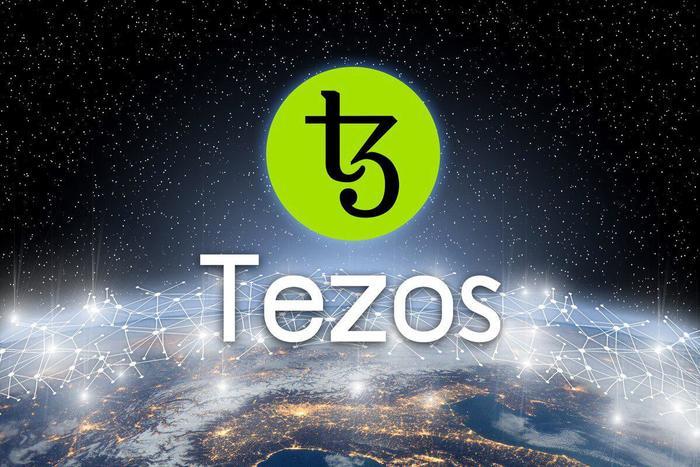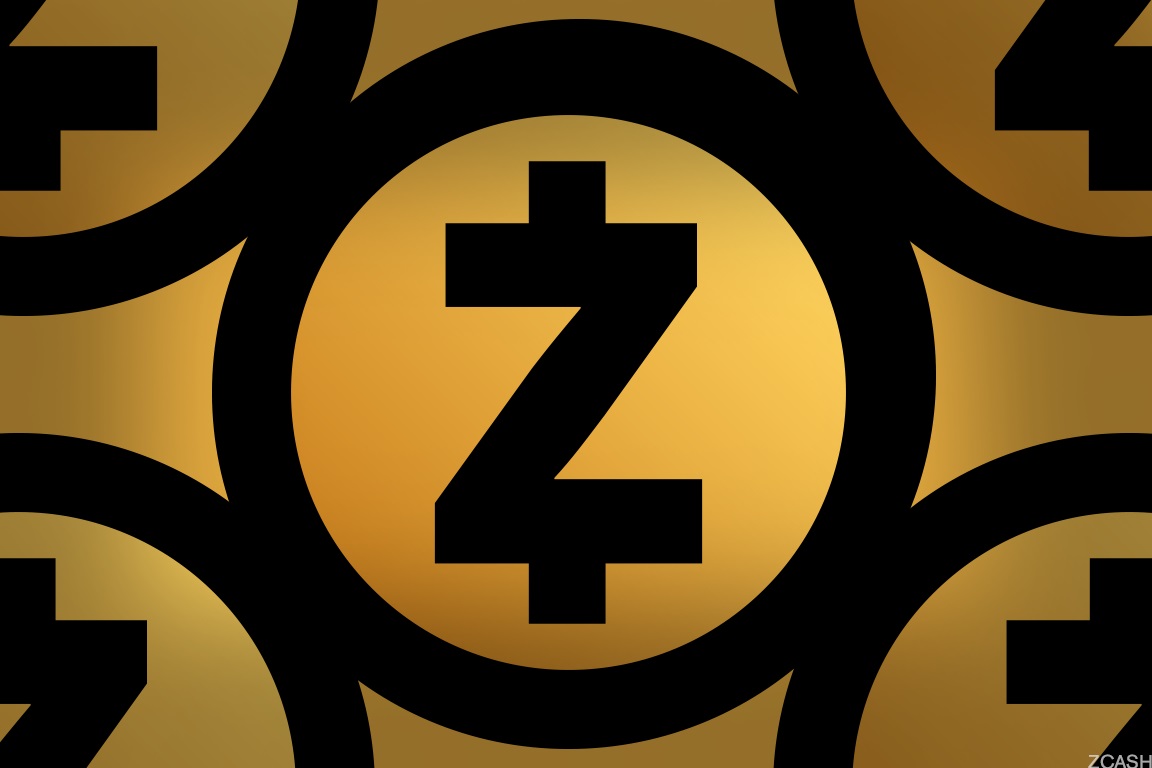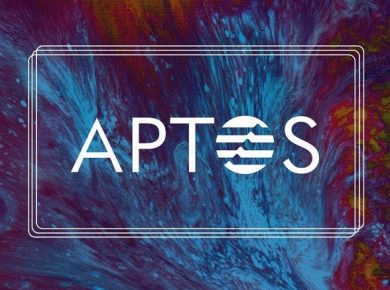If you are involved in the cryptocurrency industry, you must have been hearing a lot about Tezos lately.
Tezos staking is a attractive feature of this project with a good ROI and we are going to answer some questions about staking XTZ.
Some of the largest cryptocurrency exchanges, including Binance, Coinbase and Kraken, added support for staking Tezos over the past two months.
So if you are eager to learn about staking Tezos, you have come to the right place.
What is Tezos?
Tezos is both a blockchain platform and a cryptocurrency (XTZ).
Tezos was designed for enterprises for secured application of pretty much everything that we expect from blockchain technology.
The service was first created in 2014, by a married couple, Arthur and Kathleen Breitman.
The Tezos platform is very good for automating simple contracts. It works on the basis of smart contracts for avoiding common forks and bugs.
Its underlying blockchain was built from scratch, and delivers decentralization and self-governance in a way that other cryptocurrencies lack.
Some say that Tezos is an alternative to Ethereum, since both are independent smart contract platforms, and both have an uncapped supply of coins.
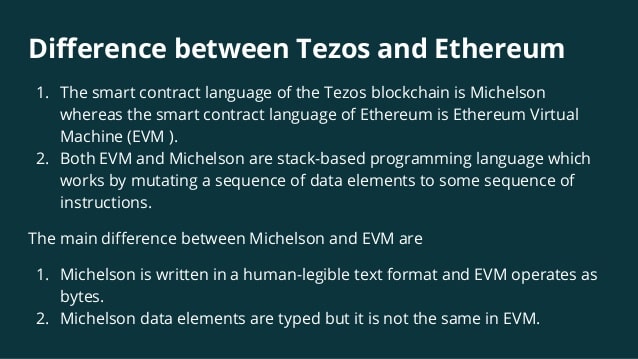
However, unlike Ethereum, Tezos offers on-chain governance that is controlled through online voting.
This means anyone can propose an amendment on the chain. If they are able to secure sufficient votes on their proposal, they can change the protocol.
This mechanism is implemented via liquid proof-of-stake protocol, and due to this, the Tezos platform is known as a self-amending cryptographic ledger.
What is liquid proof-of-stake?
Cryptocurrencies, such as Bitcoin, consume massive amounts of electricity for securing their networks.
Enormous computing power is taken up during mining of coins, due to the proof-of-work algorithm.
Thus in 2011, a new technique was introduced, called proof-of-stake.
Proof-of-stake is a consensus algorithm that uses an election process, whereby any one node is chosen at random for validating the next block.
In this model, ‘miners’ are replaced with ‘validators’, and instead of mining blocks, they ‘forge’ blocks.
This actually means that validations are conducted via virtual mining, instead of physical mining. Since this algorithm does not simply allow everyone to mine new blocks, it uses significantly less amounts of energy.
The way proof-of-stake works is that first some of the validators’ coins are locked up as stake, or in other words, put up as safety deposits.
If a validator tries to explicitly double sign a block, the safety deposit is forfeited.
Next, the validators begin to validate the blocks. If they find a block that they think should be added to the chain, they place a bet on it.
If the block gets approved and added, the validator gets a reward that is proportionate to his bet.
Tezos takes this one step forward, and incorporates liquid democracy in proof-of-stake consensus.
Liquid proof-of-stake allows people to not only directly vote on their policies, but also delegate their voting rights to others for voting on behalf of them.
There is no stated rule on how to, and whether or not an individual chooses to select delegates.
But the mechanism ensures that each individual person is able to participate in the final policy creation.
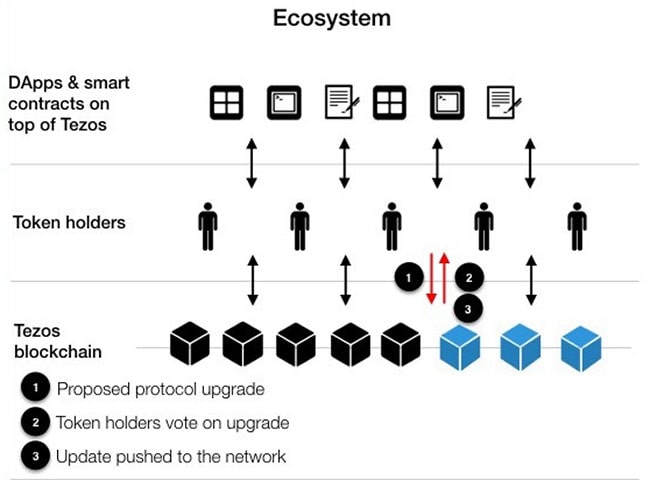
So Tezos is based on a liquid proof-of-stake system. It requires each individual to stake a certain number of Tezos coins, in order to mark their participation on the blockchain.
If someone does not have the time to vote, they can delegate their validation rights to others.
This makes the model scalable.
Delegation of validation rights or voting responsibilities lets the individuals maintain ownership of their tokens. Also, the tokens that are delegated are not locked up for a specific timeframe. Thus these tokens are always liquid.
What is baking?
The process of staking Tezos coins or XTZ is known as baking, and those who stake Tezos (or successfully create blocks) are called bakers.
To thoroughly understand what baking is, let’s compare it with the concept of mining, as in Bitcoin.
Just like Bitcoins are mined, Tezos are baked.
In Bitcoin, miners constantly contest to create or publish blocks by solving a proof-of-work problem.
In Tezos, on the other hand, instead of developing a block creation right through proof-of-work algorithm, bakers gain that right when a coin is randomly selected for block creation.
They can gain that right if either they own a Tezos coin, or when another coin owner delegates the responsibility to them.
Everyone who owns a Tezos token may not be interested to become a baker, and thus they may delegate the right to another party.
When they do that, the delegate does not get ownership of the coin, and is neither able to spend it or control it in any way. Only if the coin is selected at random to bake a block, the delegate gets the right to act as the baker.
Bakers are informed about their right to bake blocks couple of weeks in advance.
In this time, they are expected to build a safety deposit to be held for few weeks. The safety deposit is referred to as a ‘bond’ in the white paper.
In other proof-of-stake systems, this bond is a set or static amount that is staked by a delegate.
But in Tezos, it is dynamic in nature, which means it keeps changing according to the number of blocks that the delegate is assigned to create.
Purpose of the bond is to ensure the baker’s integrity throughout the block creation time period. If a baker tries to cheat or attempts to disseminate a block on multiple branches, he/she would lose the bond.
If a baker tries to create blocks on a losing branch, his/her block reward is forfeited.
This penalty is triggered when a baker explicitly tries to publish blocks on two different branches.
When a block is successfully created and circulated in the blockchain, the baker receives a block reward, along with some fees from transactions that happen in the block.
What is a delegation service?
When a Tezos token owner wants to earn baking rewards, but does not have the time or is not interested to become a baker himself, he would hire a delegation service to find a delegate who would act as the baker.
This is the securest and easiest way to gain baking rewards.
Besides the staking companies, some cryptocurrency exchanges are also beginning to offer Tezos delegation service to make the process easy for beginners.
When you hire a delegation service, any baking rewards earned will first be distributed to the service provider.
After deducting their fee, they will then send the rewards to you. Thus it is utterly important for you to be able to trust the service provider you choose.
If you find a delegation service to be widely trusted in the industry, it is likely to be good and reliable.
Normally a delegation service would only accept a limited number of Tezos tokens. If you over-delegate to them, they (and thus you) will not be able to secure rewards for any tokens beyond that limit.
How to bake Tezos independently?
The right to bake Tezos is ascribed in rolls.
Each roll is comprised of 10,000 tokens. So if you want to bake your Tezos independently, i.e. ‘home bake’, you need to own a minimum of 10,000 Tezos tokens.
Besides this, you would also need uninterrupted connection to the power and Internet, in order to run a Tezos node.
For a detailed manual on installing and setting up a Tezos node on Ubuntu, click here.
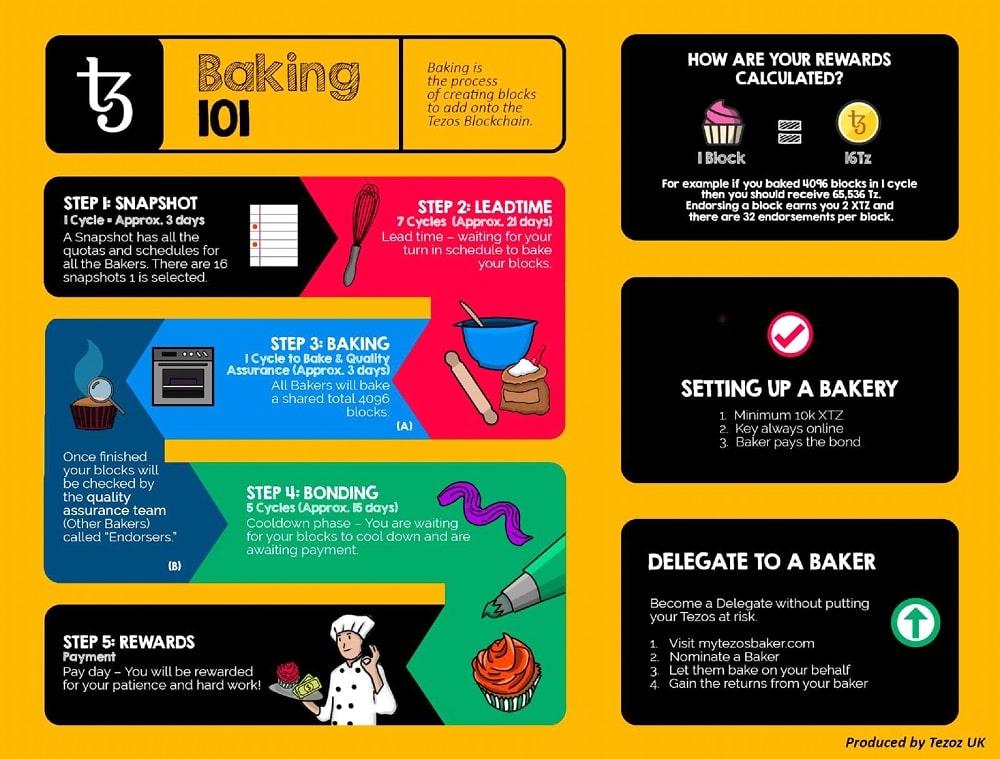
It is recommended to always keep all your baking rewards in a hardware wallet, while maintaining regular contact with the development team.
Is it safe to delegate Tezos?
As long as you choose a reliable baker or delegation service, it is safe to delegate Tezos.
When you delegate, you maintain control over your private keys, and do not transfer ownership of your coins to anyone.
It is similar to voting, whereby the voting power is hinged on the number of tokens that are held in your address.
If your delegate goes rogue, you will not be penalized. But you will be affected in the sense that you will not be able to earn the baking rewards anymore.
Most delegation service providers allow you to move your delegated coins any time you want.
All you need to do is log in into your Tezos wallet, and send your tokens to the desired destination.
The service providers usually do not impose any lock up periods on this.
How to calculate Tezos baking rewards?
Staking Tezos is a way to earn passive income through baking rewards.
The annual yield on the Tezos network is currently about 6%, before deducting the validator or delegation service provider’s fee.
When you delegate for the first time, it might take you 4-5 weeks before you receive your first baking rewards from the validator.
After that, you can expect to earn every 3 days or so. Plenty of websites offer a staking rewards calculator for you to easily estimate your earnings.
The following factors determine how much you can generally earn:
- The number of tokens you delegate.
- The percentage of all Tezos tokens being staked.
- The average time it is taking between block creation.
- The bond coverage of your validator/delegate, compared to the total number of tokens delegated to them.
- Your validator/delegate’s fee.
Tezos staking services and wallets
Following is a list of wallets and exchanges that allow staking Tezos.
- Trezor Model T (Hardware Wallet)
- Ledger Nano S (HardWare Wallet)
- AirGap
- TezBox Wallet (Web + Desktop + Mobile)
- Exodus
- Galleon Tezos Wallet (Tezori)
- Trust Wallet
- Kukai Tezos Wallet
- Atomex Tezos Wallet
- Magnum Wallet
- Atomic Wallet
- Tezos.Blue
- Guarda
- Tezos CLI Wallet
- Simplestaking
- Binance Staking
- coinbase
Staking Tezos on Binance
On December 4, 2019, Binance added support for Tezos staking, with commitment to distribute all staking rewards on the 20th of each month, and provide live snapshots to calculate and display the rewards everyday.
Unlike other cryptocurrency exchanges like Coinbase, Binance is not charging any fees for this service. It is a user acquisition strategy, and it is not clear if the service will remain free for lifetime.
On December 9, 2019, it was reported that about 500,000 Tezos (XTZ) were deposited into Binance.
This deposit was made from an unknown wallet, and was speculated to cause more XTZ tokens deposited into Binance in the near future.
Binance already has support for staking several other tokens, including NEO (NEO/GAS), Vechain (VEN/VTHO), Ontology (ONT/ONG), Stellar (XLM), Algorand (ALGO), Komodo (KMD), Stratis (STRAT) and Qtum (QTUM).
to Stake Tezos (and other coins) simply go to the menu Eran > Staking.
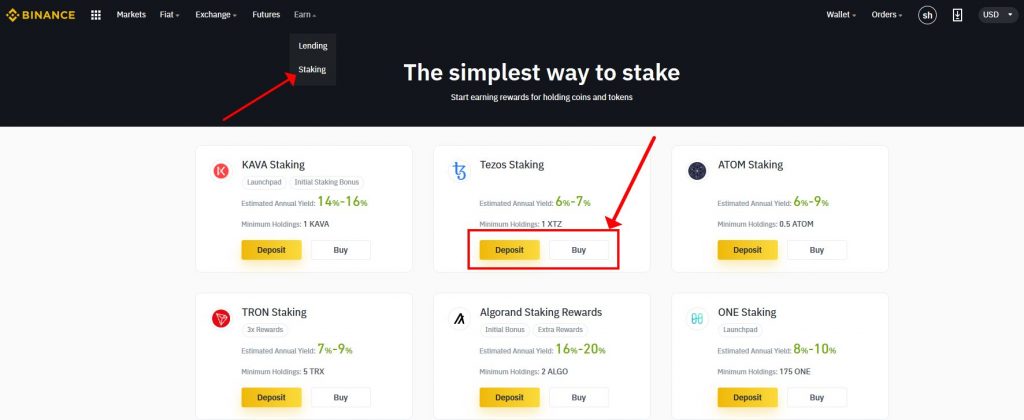
click on Deposit or Buy button to add desired amount of coins.
It was reported that Binance took this step upon seeing that Coinbase did the same in November 2019.
Although the move is good for users, it may not be good for the staking startups in the cryptocurrency industry.
It will become too difficult for staking companies to compete and survive when major crypto exchanges start offering zero-fee, easy-to-use staking models.
Staking Tezos on Coinbase
Coinbase is another giant digital currency exchange.
It is a platform for buying, selling and storing cryptocurrencies like Bitcoin, Ethereum and Litecoin.
They are known to regularly offer new ways to their customers to gain rewards by holding different cryptocurrency tokens.
Coinbase introduced Tezos staking rewards on November 6, 2019, via Coinbase Earn Tezos campaign, to provide an easy and secure way for beginners to participate in the Tezos network. Through this campaign, users can potentially earn up to $6 of Tezos, which will then be baked by Coinbase on their behalf.
The service was initially offered to only their US-based institutional clients, and then expanded to all eligible US customers.
On November 22, 2019, Coinbase announced that they are making their Tezos staking service to all investors worldwide.
It has been reported that Coinbase will soon launch staking service for other crypto tokens and blockchain networks as well, that run on proof-of-stake systems.
Final word
With the upcoming Bitcoin halving event that would affect the mining of new Bitcoins, it is good to learn about staking Tezos and all the other crypto tokens available out there.
The process of staking Tezos is getting more and more accessible to basic users, as the large and popular crypto exchanges add support for it.
It is nonetheless best to do your own due diligence and research before staking and other forms of investing in any cryptocurrency.
